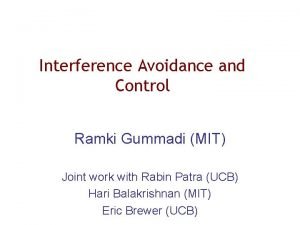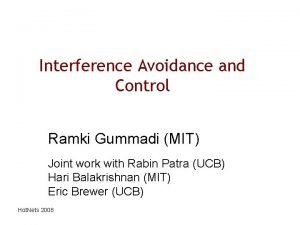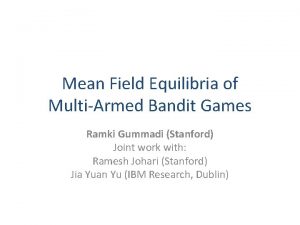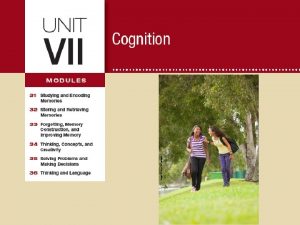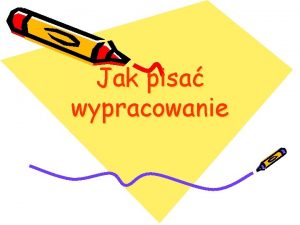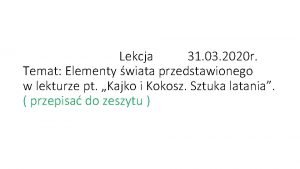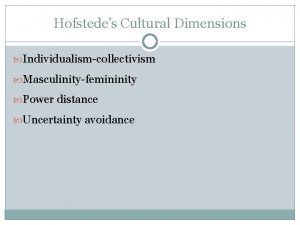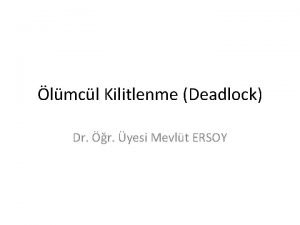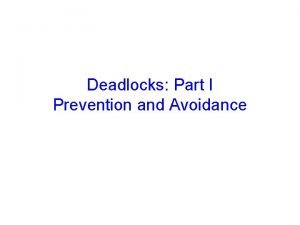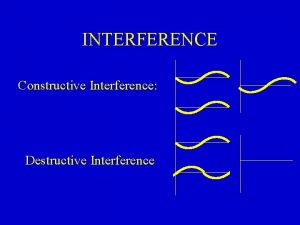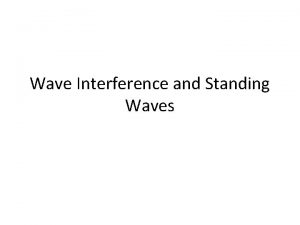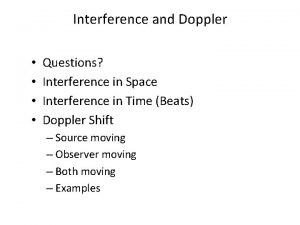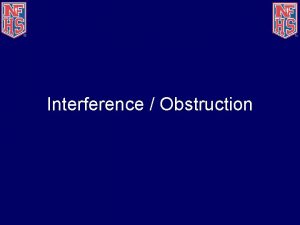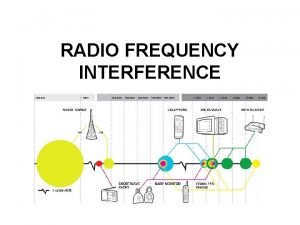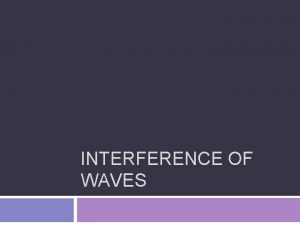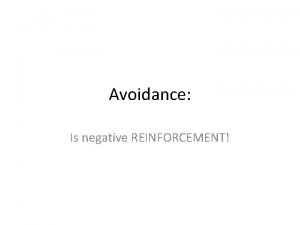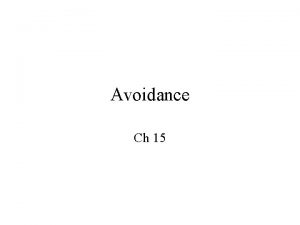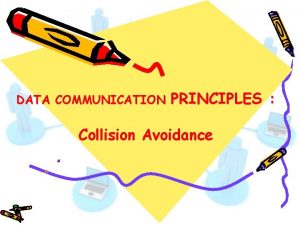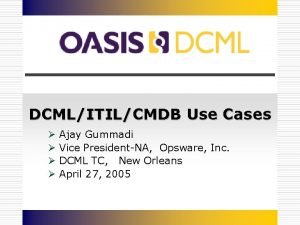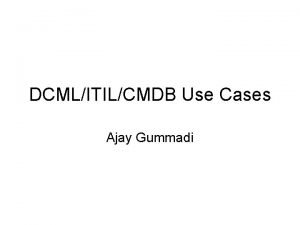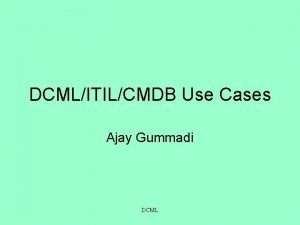Interference Avoidance and Control Ramki Gummadi MIT Joint



















- Slides: 19

Interference Avoidance and Control Ramki Gummadi (MIT) Joint work with Rabin Patra (UCB) Hari Balakrishnan (MIT) Eric Brewer (UCB) Hot. Nets 2008

Interference-limited networks § Interference: Fundamental consequence of resource sharing • Wireless LANs • 3 G, Wi. Max • Mesh networks § Increasingly interference-limited, not noise -limited Hot. Nets 2008 2

Interference: Friend or foe? § Challenges: Interference is time-varying • Bursty data traffic, not predictable voice traffic • Radio propagation hard to model or predict § Opportunity: Unlike noise, interference isn’t random • If strong enough, understand cancel it • Avoid or control internal interference • So, treating interference as noise is inefficient Hot. Nets 2008 3

Goal: Improve aggregate throughput § Concurrent transmissions improve throughput • More total received power § But they also increase interference • Eliminate interference, maintaining concurrency? Hot. Nets 2008 4

VWID: Variable WIDth channels § Interferers in orthogonal channels § Variable widths for heterogeneous SINRs and bursty demands Hot. Nets 2008 5

Key questions (and talk outline) § How does VWID compare analytically to: • TDMA? • CSMA? § How much improvement in practice? Hot. Nets 2008 6

Capacity of variable-width channels § § Multiple transmitters, one receiver Radios have a power limit Single antenna at a node Channel doesn’t vary in frequency or time • Restriction removed in implementation § Additive White Gaussian Noise (AWGN) Hot. Nets 2008 7

2 um P 2 ) N im 2 pt log (1 + O Two-transmitter capacity region R (bits/s/Hz) m su a -c pa y cit R 1 (bits/s/Hz) Transmitter 1’s Rate R 1 R 2 R 1 + R 2 Hot. Nets 2008 log (1 + P 1 ) 2 N P < log (1 + 1 ) bits/s/Hz; 2 N P < log (1 + 2 ) bits/s/Hz; 2 N P + P 2 < log (1 + 1 ) bits/s/Hz: 2 N 8

VWID throughput O R 2(bits/s/Hz) log (1 + 2 P 2 ) N ®=0 pt im um A th ro ug hp ut B at ® = P P 1 +1 P ®=1 log (1 + 2 R 1 R 2 Hot. Nets 2008 2 R 1 (bits/s/Hz) P 1 ) N P 1 < ® log (1 + ) bits/s/Hz; 2 ®N ¡ P 2 ¡ ) bits/s/Hz: < ( 1 ®) log (1 + 2 (1 ®)N 9

VWID vs. TDMA: Two-node case § TDMA throughput: ¡ § VWID throughput: log (2 C 1 + 2 C 2 2 1) > C 1 +C 2 ; C 1 2 § Improvement higher for smaller allocations, due ® to additional in P P Hot. Nets 2008 ®N ) vs. log (1 + 2 P 1 ); C 2 N = log (1 + 2 P 2 ) N R 2(bits/s/Hz) 2 2 2 C 1 +C 2 2 log (1 + = log (1 + N ) P 2 ) N A VWID TDMA B log (1 + 2 R 1 P 1 ) N 10

VWID vs. TDMA: n-node case log (1 + 2 N ) ! +n. Pweak P § VWID throughput log (1 + strong ) 2 N Hot. Nets 2008 Relative throughput 5 transmitters at 10 d. B SINR § VWID improves throughput µ(log (n)) 2 by bits/s/Hz with n transmitters log (1 + n P ) log (1 + P ) 2 2 N vs. N • § SINRs show large improves variation throughput VWID § With n weakwith nodes and one linearly power (d. B) of stronger node strong node, aggregate ! TDMA throughput Pweak 6 th node SINR (d. B) 11

VWID vs. CSMA: Two-node case 1 1 2 R 1 +R 2 2 1 2 Two transmitters, one at 10 d. B SINR Relative throughput § Time Rto, send two bits at 1 + 1 : R rates 1 2 R R ·throughput: f g § CSMA node = RR 1 min R ; R VWID improves aggregate throughput • Hurts stronger linearly withnode total received power (d. B) 1 R 1 + 1 R 2 § VWID aggregate throughput improves with the total received power Hot. Nets 2008 2 nd node SINR (d. B) 12

Key questions (and talk outline) § How does VWID compare analytically to: • TDMA? • CSMA? § How much improvement in practice? Hot. Nets 2008 13

VWID design § Channel assignment algorithm • 5, 10 or 20 MHz variable-width sub-channels • Maximize measured aggregate throughput • Fairness: Don’t degrade link throughput • Exhaustive search for sub-channels § Accounts for frequency-selective fading § Worst-case exponential in interferers Hot. Nets 2008 14

Evaluation testbed § Outdoor testbed • Worst-case scenario (unequal SINRs) 1, E 2 § 10 links (2 -4 km), 25 d. Bi antennas, 5. 3 GHz, Atheros § Point-point and point-multipoint topologies § CSMA MAC • Higher throughput than TDMA if traffic is bursty § Unidirectional UDP traffic Hot. Nets 2008 15

Point-point throughput improvement Median link throughput improves by 50% VWID Point-Point No VWID, Point-Point Hot. Nets 2008 16

Point-Multipoint throughput improvement VWID Point-Point No VWID, Point-Point Worst link throughput improves by 2 x Hot. Nets 2008 17

Related Work § Interference cancellation • • Decode colliding transmissions jointly Signals typically differ by large SINR or coding rates § Zig. Zag decoding st 21 nd timeslot • No coordination, but no net concurrency increase Hot. Nets 2008 18

Conclusions § Increase concurrency, total received power § Throughput improvements ~ 50 -100% over TDMA and CSMA § Weakness: Inter-AP coordination (tomorrow) § Future work: Practical implementation Hot. Nets 2008 19
 Ramki gummadi
Ramki gummadi Ramki gummadi
Ramki gummadi Ramki gummadi
Ramki gummadi Retroactive interference
Retroactive interference Proactive interference vs retroactive interference
Proactive interference vs retroactive interference Rozprawka jak napisać
Rozprawka jak napisać Do postaci dobierz odpowiednie cechy z ramki
Do postaci dobierz odpowiednie cechy z ramki Ramki chebrolu
Ramki chebrolu Yandeks.kartinki
Yandeks.kartinki Which joint is permanent type
Which joint is permanent type Ellipsoid joint examples
Ellipsoid joint examples Power distance map
Power distance map Laray m. barna (1997)
Laray m. barna (1997) Deadlock prevention or avoidance
Deadlock prevention or avoidance Starvation deadlock
Starvation deadlock Deadlock prevention and avoidance
Deadlock prevention and avoidance Lamb quality grades
Lamb quality grades Costovertebral joint
Costovertebral joint Memorandum joint venture account
Memorandum joint venture account Lamb grading chart
Lamb grading chart
